IPSO Smart Object Guideline
Smart Objects Expansion Pack
Internet Protocol for Smart Objects (IPSO) Alliance
Technical Guideline
IPSO Smart Object Committee
27 October, 2015
Copyright 2015
IPSO Alliance
©2015 IPSO Alliance
1
�
1. Introduction
The availability of Internet Protocol (IP) on constrained devices with memory sizes of 16 kilobytes or
less, including IPV6 and 6LowPAN, has made possible a new kind of interoperability for connected
devices and Smart Objects.
The IETF specify a set of standard protocols for IP-enabled networks in Constrained Resource
Environments (CoRE), including the Constrained resource Application Protocol [2] (CoAP, RFC 7252)
applicable to low power and low connection bandwidth devices. CoAP is an application protocol for
machines and connected devices, as http is for web browsers, but designed specifically for machine
interaction and operation over networks of constrained devices.
IPSO Smart Object Guidelines provide a common design pattern, an object model, that can effectively use
the IETF CoAP protocol to provide high level interoperability between Smart Object devices and
connected software applications on other devices and services.
Originally based on OMA LWM2M [1] Object model, IPSO Objects expand the definition it by means of
reusable resources. IPSO Smart Objects can be registered with the OMA Name Authority (OMNA)
enabling some degree of compliance between existing LWM2M and IPSO ones.
The first set of 18 Smart Objects were intended as a “Starter Pack” and as example of how to use Smart
Objects on some application specific use cases.
To complement the initial set of objects, this new IPSO Smart Object Expansion Pack was created. The
Expansion Pack covers a new set of 16 Common Template sensors, 6 Special template sensors, 5
Actuators and 6 Control switch types.
Some of the new objects are generic in nature, such as voltage, altitude or percentage, while others are
more specialized like the Color Object or the Gyrometer Object. New Actuators and Controllers are
defined such as timer or buzzer and Joystick and Level. All of these objects were found to be necessary on
a variety of use case domains.
The IPSO Alliance is committed to making it easy for people to create new objects based on their use case
needs, while promoting reusable and cross-domain standards to as great an extent as is practical.
©2015 IPSO Alliance
2
�
2. IPSO Smart Object Summary
IPSO Smart Objects are based on the object model specified in OMA LightWeight M2M [1] Chapter 6,
Identifiers and Resources.
An IPSO Smart Object is a specified collection of reusable resources (See Table 2, Reusable Resources)
that has a well-known object ID (See Table 1, Smart Objects) and which represents a particular type of
physical sensor, actuator, connected object or other data source. The reusable resources, which make up
the Smart Object, represent static and dynamic properties of the connected physical object and the
embedded software contained therein.
This document defines a set of IPSO Smart Objects, which conform to the OMA LWM2M Object Model,
and which can be used as data objects, or web objects, to represent common sensors, actuators, and data
sources.
Table 1 Summarizes the Objects defined by this Technical Guideline.
©2015 IPSO Alliance
3
�
Table 1. Smart Objects defined by this Technical Guideline
Type
Common
Template
Sensors
Special
Template
Sensors
Actuators
Controls
Object
Voltage
Current
Frequency
Depth
Percentage
Altitude
Load
Pressure
Loudness
Concentration
Acidity
Conductivity
Power
Power Factor
Rate
Distance
Energy
Direction
Time
Gyrometer
Color
GPS Location
Positioner
Buzzer
Audio Clip
Timer
Addressable Text Display
On/Off Switch
Push Button
Level Control
Up/Down Control
Multistate Selector
Multiple Axis Joystick
Object ID
3316
3317
3318
3319
3320
3321
3322
3323
3324
3325
3326
3327
3328
3329
3346
3330
3331
3332
3333
3334
3335
3336
3337
3338
3339
3340
3341
3342
3347
3343
3344
3348
3345
©2015 IPSO Alliance
4
�
3. Common Template Sensors
The following subsections include the new IPSO Objects and their Descriptions. The following Objects
use a common template with the same default resource structure shared by all of the basic objects.
Resources:
Resource Name Resource
Descriptions
Mandatory
Units
Multiple
Instances?
Type
Range or
Enumeration
Defined
by
“Units”
resource.
ID
5700
Access
Type
R
No Mandatory
Float
Sensor
Value
Units
5701
R
No
Optional
String
Last or
Current
Measured
Value from
the Sensor
Measurement
Units
Definition e.g.
“Cel” for
Temperature
in Celsius.
The minimum
value
measured by
the sensor
since power
ON or reset
The maximum
value
measured by
the sensor
since power
ON or reset
The minimum
value that can
be measured
by the sensor
The maximum
value that can
be measured
by the sensor
Reset the Min
and Max
Measured
Values to
Current Value
5601
R
No
Optional
Float
5602
R
No
Optional
Float
5603
R
No
Optional
Float
5604
R
No
Optional
Float
Same as
Measured
Value
Same as
Measured
Value
Same as
Measured
Value
Same as
Measured
Value
Same as
Measured
Value
Same as
Measured
Value
Same as
Measured
Value
Same as
Measured
Value
5605
E
No
Optional
Min
Measured
Value
Max
Measured
Value
Min
Range
Value
Max Range
Value
Reset Min
and Max
Measured
Values
©2015 IPSO Alliance
5
�
Access
Type
R,W
Multiple
Instances?
No
Mandatory
Type
Optional
Float
5750
R,W
No
Optional
String
Resource Name Resource
ID
5535
Calibration
Offset
Application
Type
Range or
Enumeration
Units
Descriptions
Read or Write
the calibration
offset value
The
application
type of the
sensor or
actuator as a
string
depending on
the use case.
IPSO Object: Voltage
3.1
Description: This IPSO object should be used with voltmeter sensor to report measured voltage between
two points. It also provides resources for minimum and maximum measured values, as well as the
minimum and maximum range that can be measured by the sensor. An example measurement unit is volts
(ucum: V).
Object Info:
Object
Object ID
Object URN
Voltage
3316
urn:oma:lwm2m:ext:3316
Multiple
Instances?
Yes
Description
Voltage, example units = V
IPSO Object: Current
3.2
Description: This IPSO object should be used with an ammeter to report measured electric current in
amperes. It also provides resources for minimum and maximum measured values, as well as the minimum
and maximum range that can be measured by the sensor. An example measurement unit is volts (ucum:
A).
Object Info:
Object
Object ID
Object URN
Current
3317
urn:oma:lwm2m:ext:3317
Multiple
Instances?
Yes
Description
Current, example units = A
©2015 IPSO Alliance
6
�
IPSO Object: Frequency
3.3
Description: This IPSO object should be used to report frequency measurements. It also provides
resources for minimum and maximum measured values, as well as the minimum and maximum range that
can be measured by the sensor. An example measurement unit is volts (ucum: Hz).
Object Info:
Object
Object ID
Object URN
Frequency
3318
urn:oma:lwm2m:ext:3318
Multiple
Instances?
Yes
Description
Frequency, example units =
hertz (Hz)
IPSO Object: Depth
3.4
Description: This IPSO object should be used to report depth measurements. It can, for example, be used
to describe a generic rain gauge that measures the accumulated rainfall in millimetres (mm) or in fathoms
(fth).
Object Info:
Object
Depth
Object ID
Object URN
3319
urn:oma:lwm2m:ext:3319
Multiple
Instances?
Yes
Description
Depth, example units =
millimeters (mm)
IPSO Object: Percentage
3.5
Description: This IPSO object should can be used to report measurements relative to a 0-100% scale. For
example it could be used to measure the level of a liquid in a vessel or container in units of %.
Object Info:
Object
Object ID
Object URN
Percentage
3320
urn:oma:lwm2m:ext:3320
Multiple
Instances?
Yes
Description
Percentage, example units = %
©2015 IPSO Alliance
7
�
IPSO Object: Altitude
3.6
Description: This IPSO object should be used with an altitude sensor to report altitude above sea level in
meters. Note that Altitude can be calculated from the measured pressure given the local sea level pressure.
It also provides resources for minimum and maximum measured values, as well as the minimum and
maximum range that can be measured by the sensor. An example measurement unit is meters (ucum: m).
Object Info:
Object
Object ID
Object URN
Altitude
3321
urn:oma:lwm2m:ext:3321
Multiple
Instances?
Yes
Description
Altitude, example units =
meters (m)
IPSO Object: Load
3.7
Description: Description: This IPSO object should be used with a load sensor (as in a scale) to report the
applied weight or force. It also provides resources for minimum and maximum measured values, as well
as the minimum and maximum range that can be measured by the sensor. An example measurement unit
is kilograms (ucum: Kg).
Object Info:
Object
Load
Object ID
Object URN
3322
urn:oma:lwm2m:ext:3322
Multiple
Instances?
Yes
Description
Load, example units =
kilograms (KG)
IPSO Object: Pressure
3.8
Description: This IPSO object should be used to report pressure measurements. It also provides resources
for minimum and maximum measured values, as well as the minimum and maximum range that can be
measured by the sensor. An example measurement unit is pascals (ucum: Pa).
Object Info:
©2015 IPSO Alliance
8
�
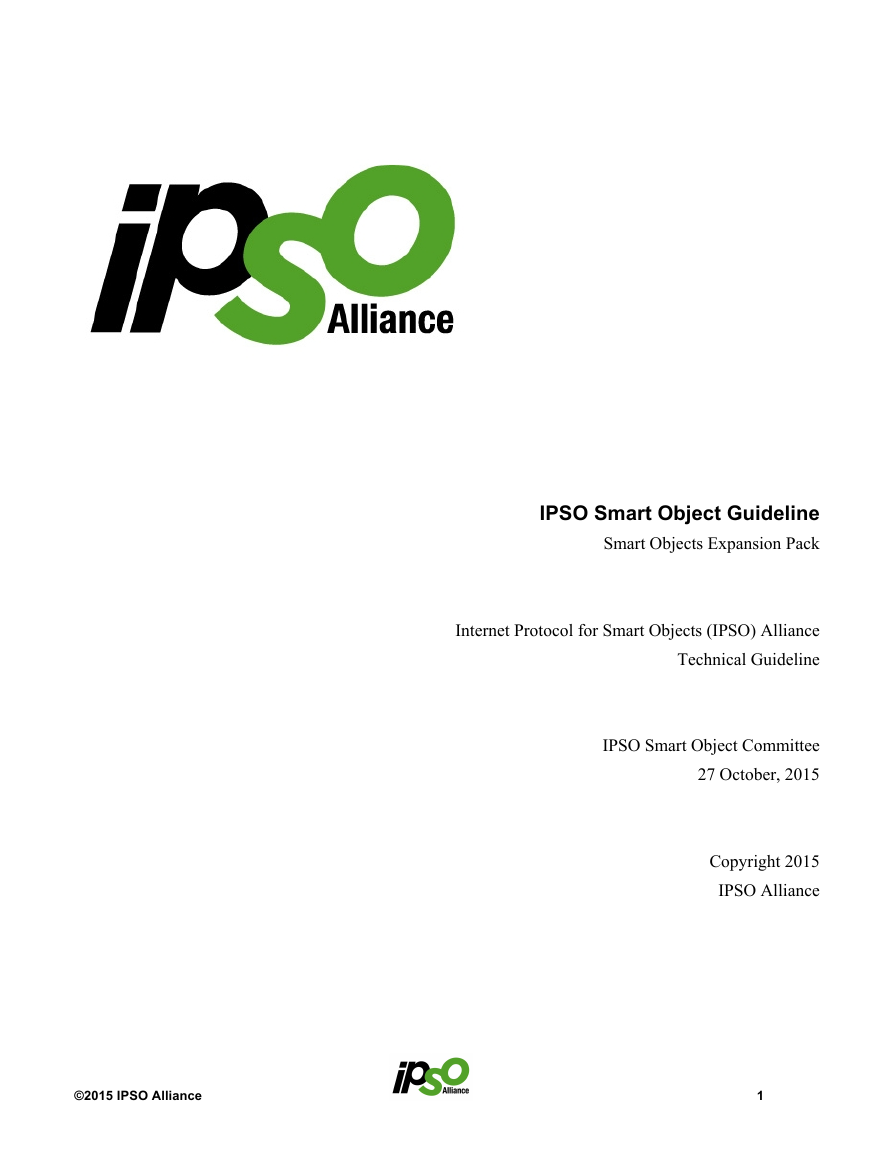
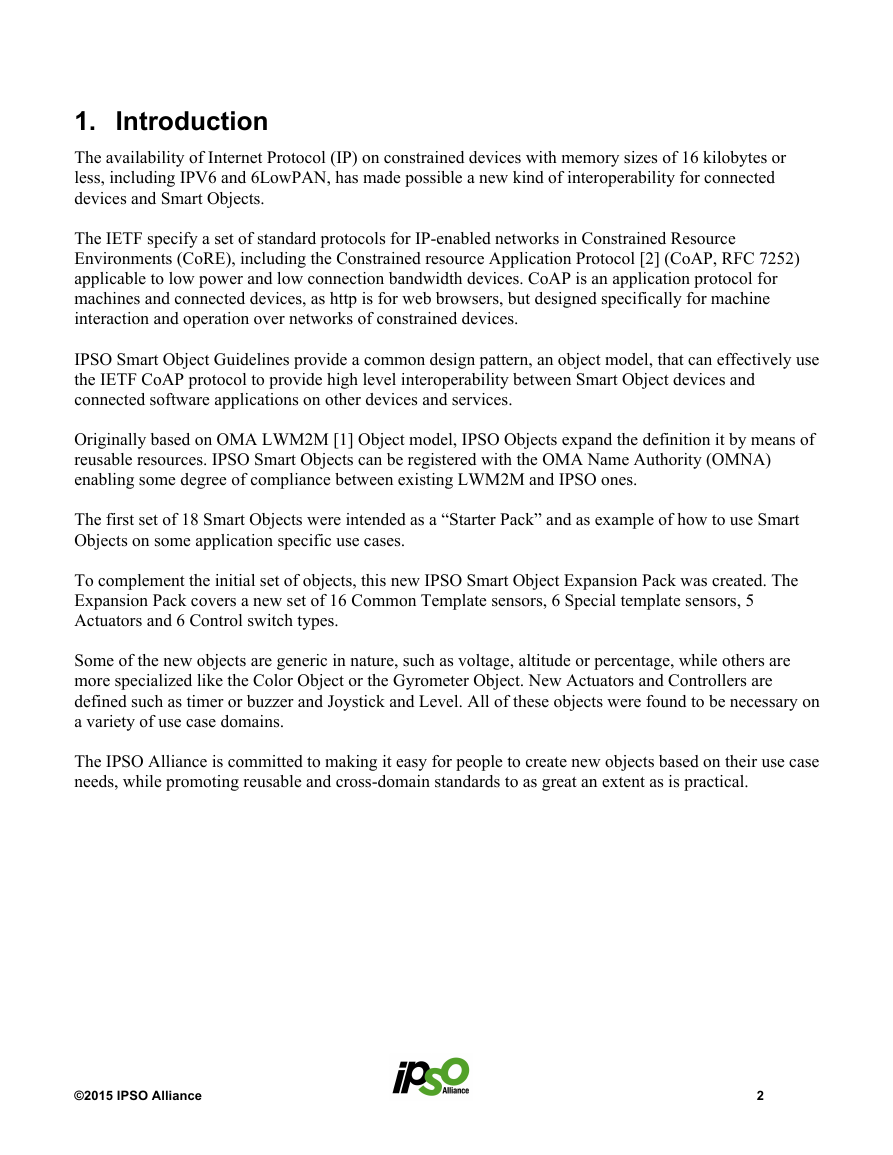
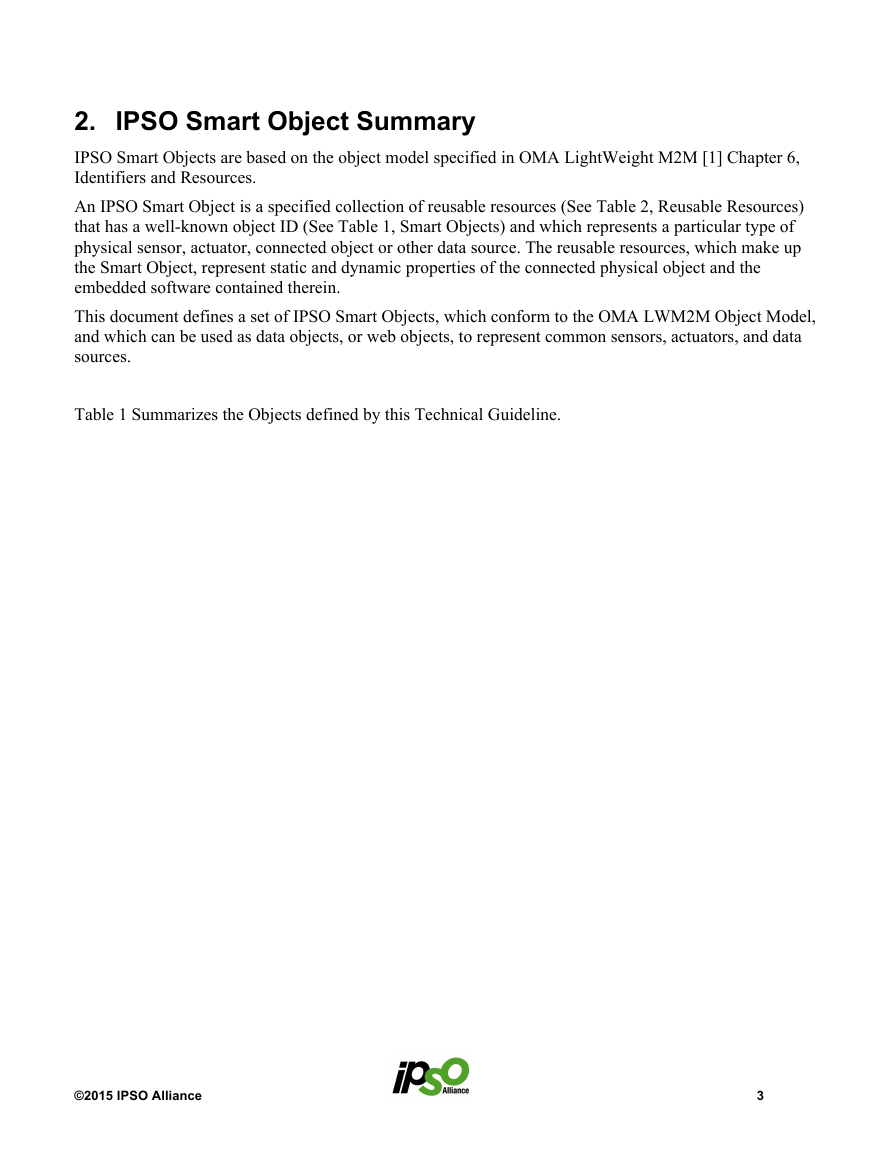
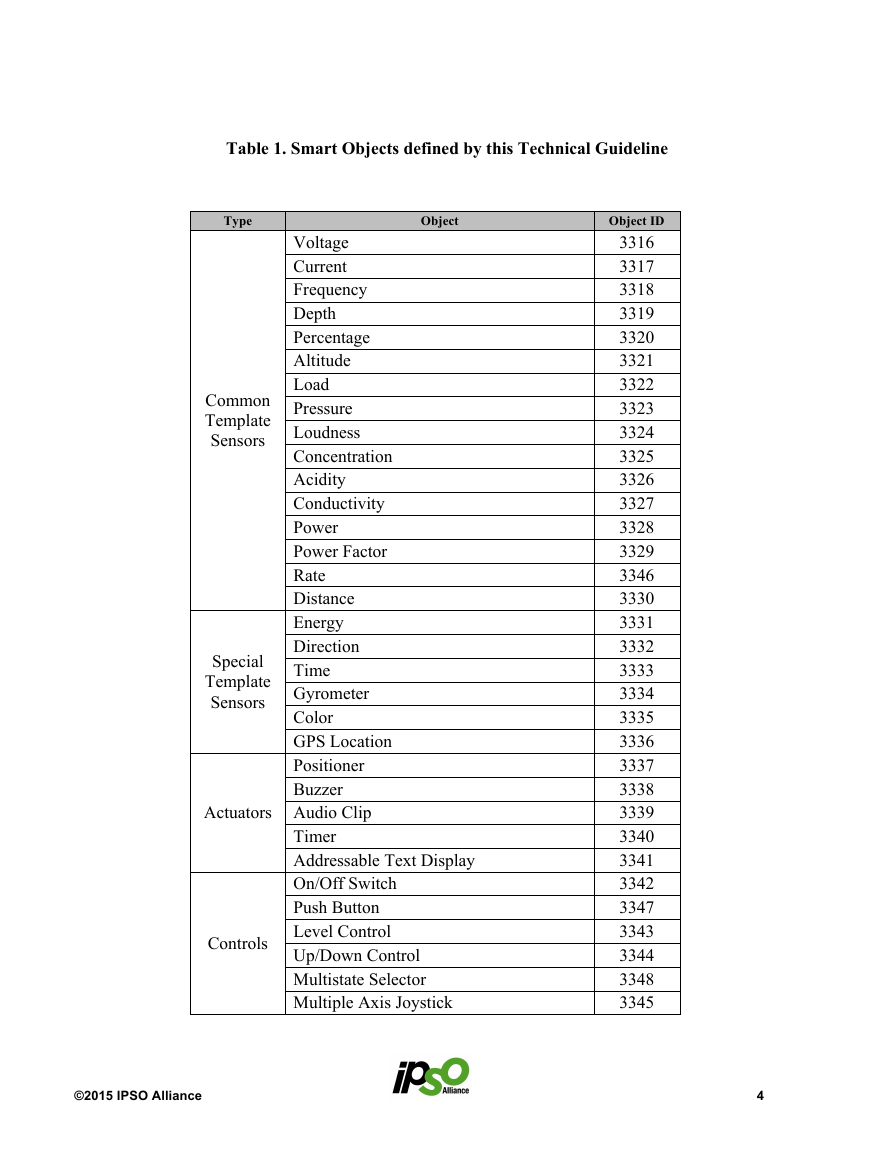
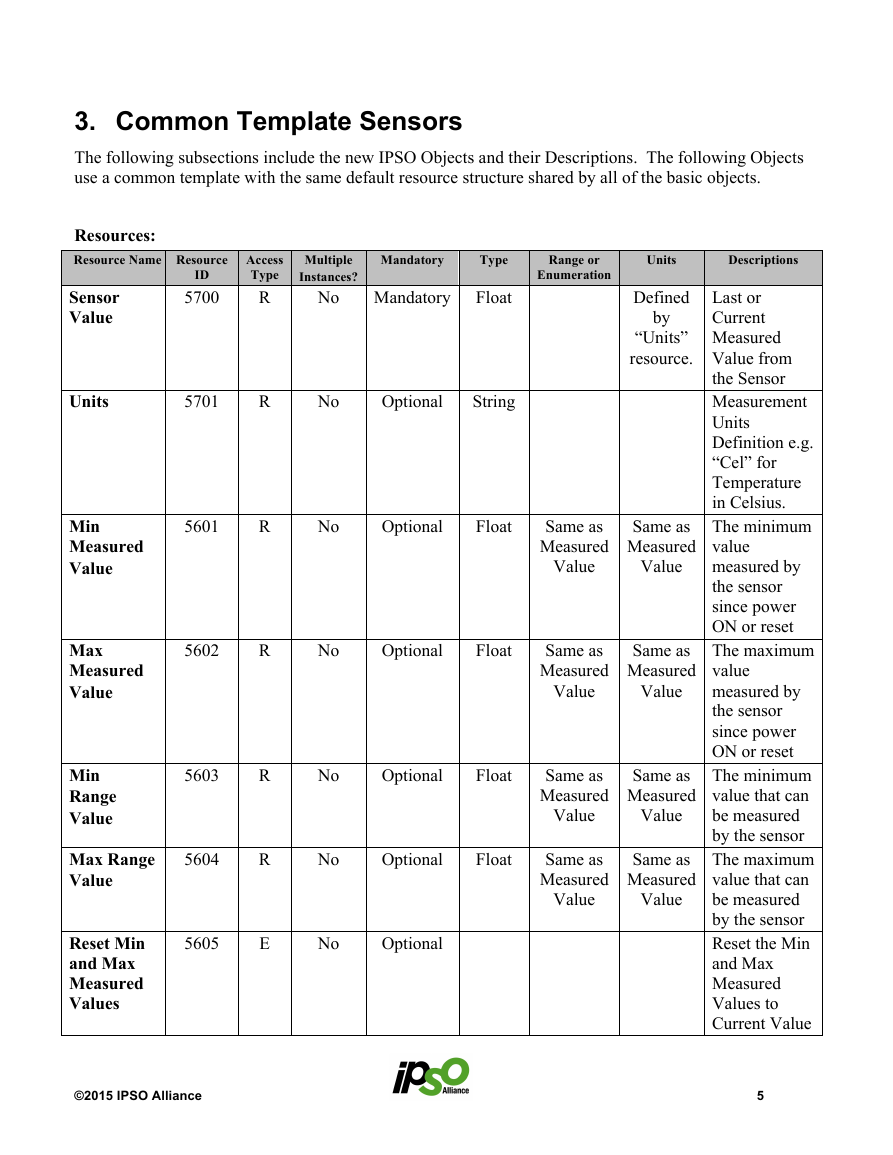
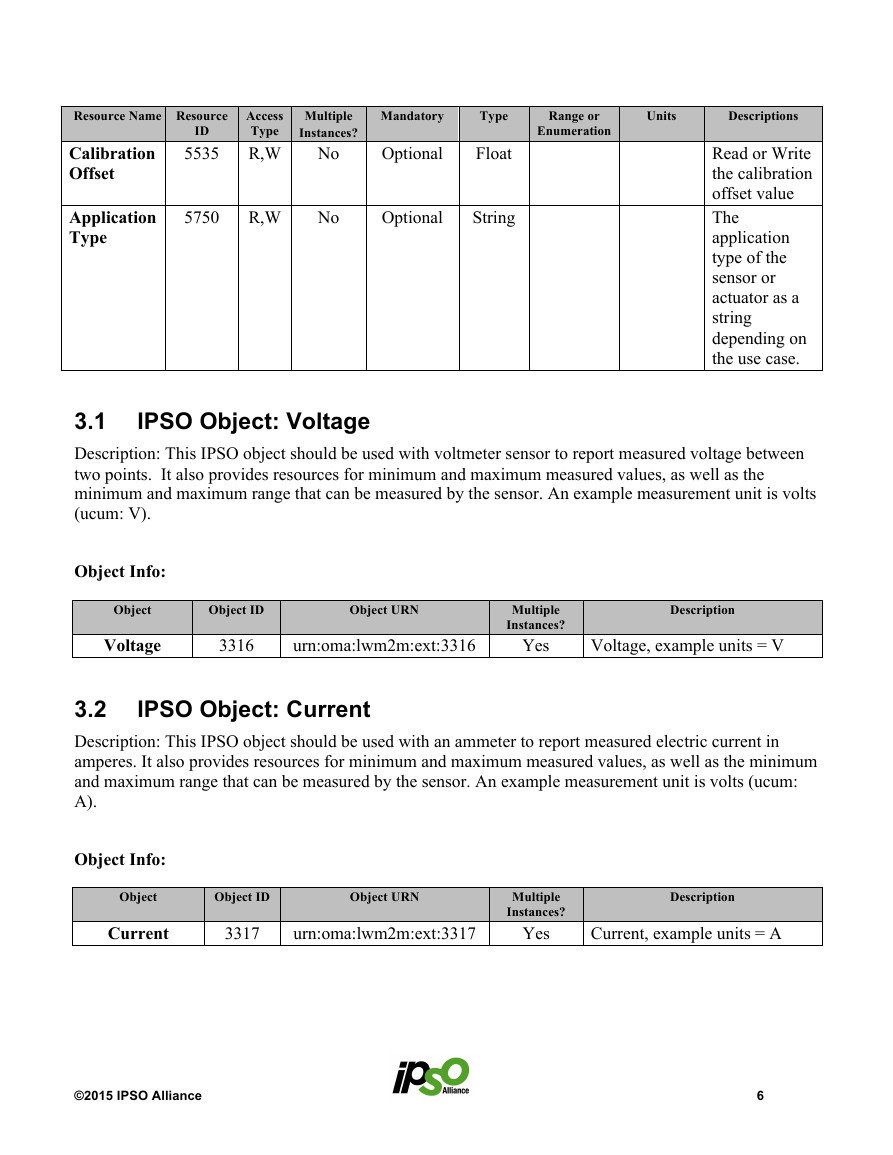
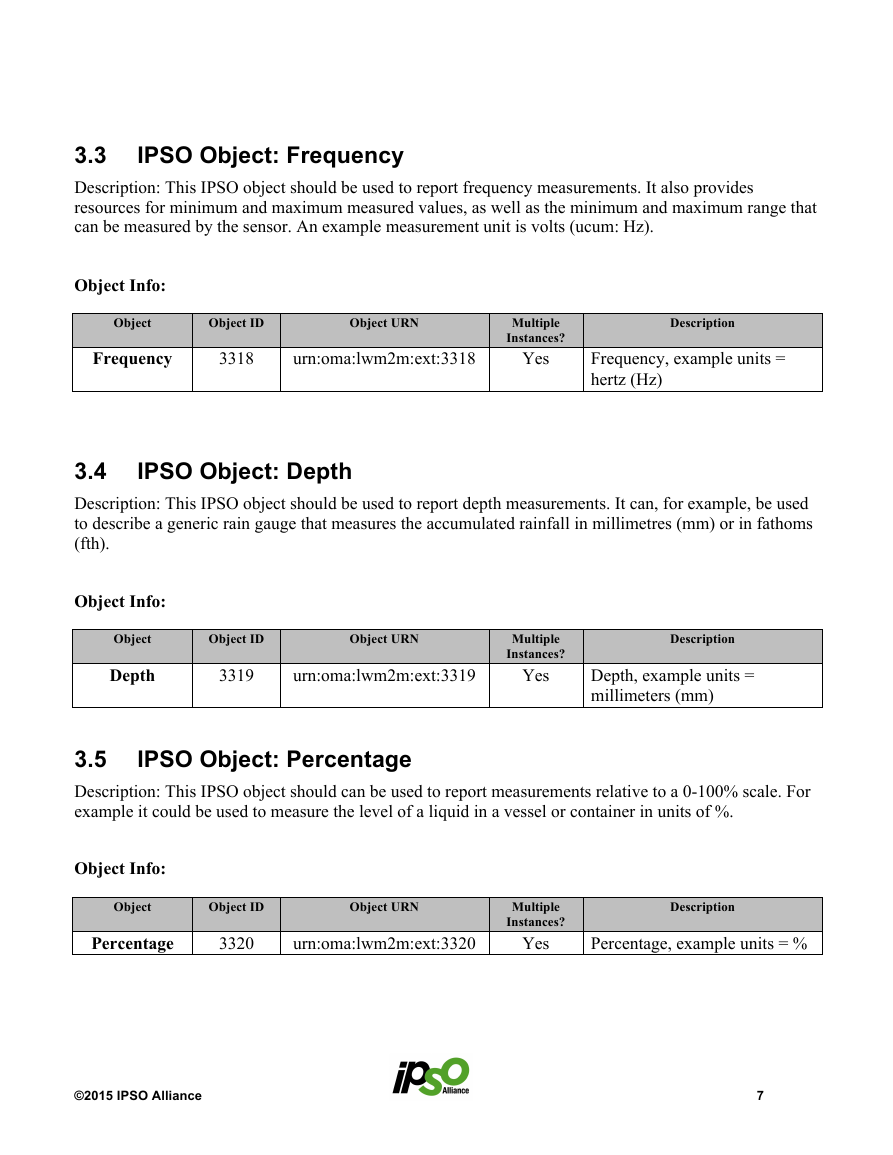
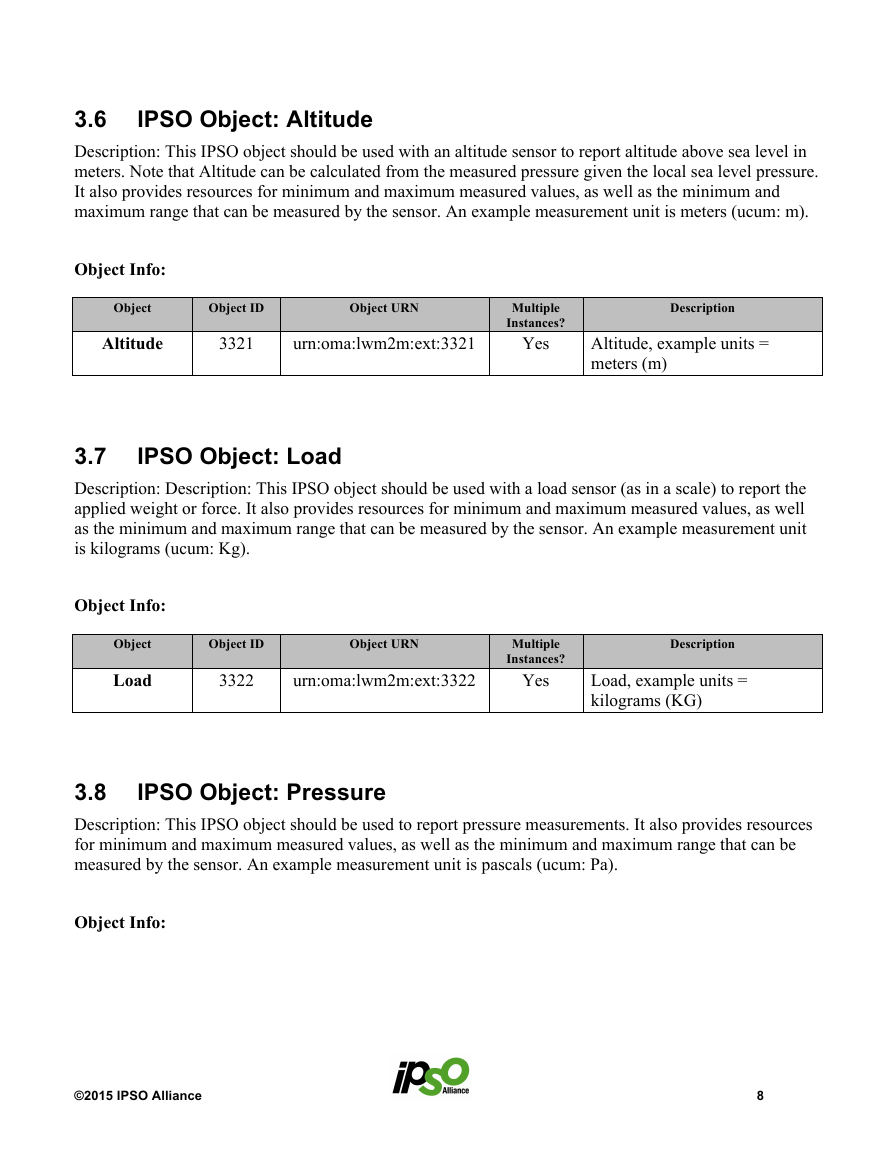








 2023年江西萍乡中考道德与法治真题及答案.doc
2023年江西萍乡中考道德与法治真题及答案.doc 2012年重庆南川中考生物真题及答案.doc
2012年重庆南川中考生物真题及答案.doc 2013年江西师范大学地理学综合及文艺理论基础考研真题.doc
2013年江西师范大学地理学综合及文艺理论基础考研真题.doc 2020年四川甘孜小升初语文真题及答案I卷.doc
2020年四川甘孜小升初语文真题及答案I卷.doc 2020年注册岩土工程师专业基础考试真题及答案.doc
2020年注册岩土工程师专业基础考试真题及答案.doc 2023-2024学年福建省厦门市九年级上学期数学月考试题及答案.doc
2023-2024学年福建省厦门市九年级上学期数学月考试题及答案.doc 2021-2022学年辽宁省沈阳市大东区九年级上学期语文期末试题及答案.doc
2021-2022学年辽宁省沈阳市大东区九年级上学期语文期末试题及答案.doc 2022-2023学年北京东城区初三第一学期物理期末试卷及答案.doc
2022-2023学年北京东城区初三第一学期物理期末试卷及答案.doc 2018上半年江西教师资格初中地理学科知识与教学能力真题及答案.doc
2018上半年江西教师资格初中地理学科知识与教学能力真题及答案.doc 2012年河北国家公务员申论考试真题及答案-省级.doc
2012年河北国家公务员申论考试真题及答案-省级.doc 2020-2021学年江苏省扬州市江都区邵樊片九年级上学期数学第一次质量检测试题及答案.doc
2020-2021学年江苏省扬州市江都区邵樊片九年级上学期数学第一次质量检测试题及答案.doc 2022下半年黑龙江教师资格证中学综合素质真题及答案.doc
2022下半年黑龙江教师资格证中学综合素质真题及答案.doc